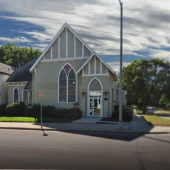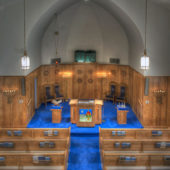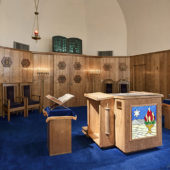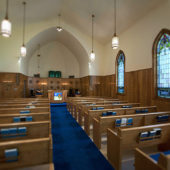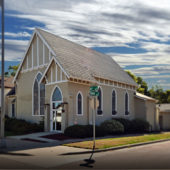Mount Zion is a Reform congregation that welcomes Jews of all backgrounds and opinions to come together for study and prayer.
In the late 1870s, more than two decades before South Dakota statehood, German Jews began settling in Sioux Falls. They were attracted by opportunities in mercantile trade. Most maintained contact with larger Jewish communities through the synagogues, while some drifted away from the faith. In the early 1880s/1890s a much larger wave of Jewish immigrants primarily from Russia and Romania traveled westward, some settling in Sioux Falls. Christians and the IRO (Industrial Removal Office) assisted the new immigrants. They helped to get them out of the overcrowded ghettos of the big cities and to move them into the Midwest. B’nai Brith (the largest and oldest Jewish service organization, founded in 1843) helped to find the new immigrants jobs.
Some Jews entered the U.S. through the Great Lakes ports and others through Canada, in order to avoid Ellis Island. The German Jews in Sioux Falls began meeting as a congregation in 1903, calling themselves Mount Zion. One of their first actions was to purchase land for a cemetery they named Mt. Vine. The first grave in the cemetery is dated 1904.
The two groups, Russian Jews who practiced Conservative-Orthodox Judaism and German Jews who practiced Reform Judaism, met separately in rented buildings. In 1916 the Russian group established another cemetery they named The Sons of Israel. The Russian (Conservative) and German (Reform) Jews tried meeting together, but it didn’t work out. In 1919 the German Jews bought an 1894 church building, which belonged to a Lutheran congregation. They shared the building with the Lutherans for a year and subsequently began changing it. The windows were altered and the Christian symbols were removed. In 1926 it was dedicated as a Reform Jewish temple.
The first Rabbi arrived in 1920, Salvador J. Schwab. He served for two years. The next leader was a lay-leader, a well-educated attorney whose father was Rabbi. He served until about 1926. The next Rabbi, Howard Feinberg, came in 1932, and he served for ten years. Rabbi Karl Richter, a German refugee, served from 1942 until 1950. He had held one post prior to this in Missouri. Rabbi Richter, who was very popular, came back to speak on several occasions, after he had retired. Michael Szenes served from 1951 to 1953. From 1953 Rabbi Eugene Hibshman served the congregation until he passed away in 1978. Because Sioux Falls’ Jewish community had shrunk in size, the congregation then chose a part-time local Rabbi, Stephen Forstein, who served until 1984. Since that time, the temple has had many student Rabbis. The congregation’s largest membership was probably during the 1930s and 1940s, comprising at least 75 families. Membership usually averaged 60 to 65 families. Today, most members are between 40 and 80 years old, with very few children. The congregation was once associated with of B’nai Brith, held dances and served at homeless shelters, but this is no longer the case due to the aging membership. However, the temple remains quite active, and is currently running a religious school, a Sisterhood, a Hadassah Chapter in town, a Torah study Saturday mornings and services every Friday night. A student Rabbi leads services two weekends a month, with lay leaders serving other two weekends.
Mount Zion’s exterior is an attractive gray A-frame structure with Gothic arched stained-glass windows, offset by white woodwork. Inside the prayer room, white walls feature dado railing with wood paneling underneath. Gothic stained glass windows adorn the south side wall and two rectangular stained-glass windows adorn the back (west) wall. The entire bimah is led under a sweeping archway into a concave area at the front of the sanctuary. Wood paneling continues to line the lower half of the wall, where the Aron Kodesh is situated. Ornate pieces of darker wood with Jewish symbols are set against the paneling, four against the doors of the Aron Kodesh. A large, simply carved tivah (reader’s desk) is placed in front of the Aron Kodesh. Twin tablets of black, with The Ten Commandments in Hebrew, colored in turquoise, rest on top of the dado rail on top of the Aron Kodesh. Simple, elegant light fixtures drop down from the white soaring ceiling throughout the prayer room. Simply carved wood benches sit on royal blue carpeting, filling up the sanctuary. There is an upstairs gallery at the back of the prayer room, with a white panel trimmed in wood separating it from the main sanctuary.

